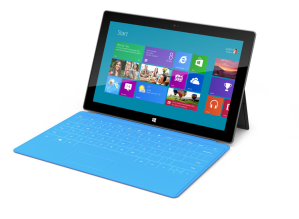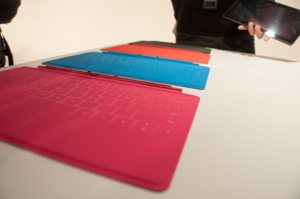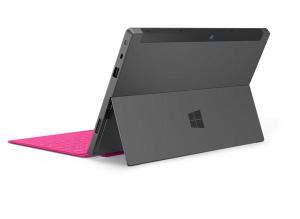Monday June 18th was a weird day in the tech world, for once Microsoft managed to create a buzz and a stir regarding an announcement they were to make, yet no one knew what that would be. This felt more like an Apple announcement than anything we have come to expect from Microsoft – which is a good thing and lead to a lot of speculation. I too joined in with that speculation, believing that Microsoft was to announce a 7” eReader device with new partners Barnes and Noble, how wrong could I have been…

Microsoft Surface Tablet, showing off its built in stand and magentic cover that doubles as a keyboard
Microsoft Surface Family
We now know that Microsoft has announced a family of tablets named Surface. For those of you who keep up to date with technology, you would already have heard of the Surface name from Microsoft, that particular product being a multi-touch enabled table device that was highly focused and sold to businesses. Now though Surface is the brand name for Microsoft’s own made tablet devices, meaning Microsoft has gone into the tablet market in a big way.
This is a bold move from Microsoft and quite a break from tradition. Typically Microsoft doesn’t do hardware, rather it lets its OEM partners build the hardware and Microsoft focuses on the software. However, in recent years it seems the hardware that runs Windows just doesn’t look as sexy as anything produced by Apple, none of the devices have that wow factor which can only harm sales. The latest ultimate laptops are starting to compete, but it has taken a long time for many of the OEMs to get with the game and start designing good looking, light weight hardware. I can’t help feeling that Microsoft has been forced into delivering its own hardware for the tablet market, simply because it cannot rely on OEMs to deliver hardware that looks as sexy as that produced by Apple.
Microsoft Surface Devices
Essentially Microsoft has shown us two tablets, one that runs Windows 8 RT on an ARM based processor tablet, and the other, running full blown Windows 8 pro on a tablet powered by an Intel Ivy Bridge processor. Here is some information on the specs:
- A full-size USB port and a 16:9 aspect ratio angled at 22 degrees.
- 10.6-inch, 16:9 widescreen HD Display.
- Integrated Kickstand: Built-in kickstand lets users move Surface from active use to passive consumption.
- Touch Cover: 3 mm pressure-sensitive Touch Cover senses keystrokes as gestures will come in different colors.
Surface for Windows RT
- OS: Windows RT
- Light(1): 676 g
- Thin(2): 9.3 mm
- Clear: 10.6″ ClearType HD Display
- Energized: 31.5 W-h
- Connected: microSD, USB 2.0, Micro HD Video, 2×2 MIMO antennae
- Productive: Office ‘15′ Apps, Touch Cover, Type Cover
- Practical: VaporMg Case & Stand
- Configurable: 32 GB, 64 GB
Surface for Windows 8 Professional
- OS: Windows 8 Professional
- Light(1): 903 g
- Thin(2): 13.5 mm
- Clear: 10.6-inch ClearType Full HD Display
- Energized: 42 W-h
- Connected: microSDXC, USB 3.0, Mini DisplayPort Video, 2×2 MIMO antennae
- Productive: Touch Cover, Type Cover, Pen with Palm Block
- Practical: VaporMg Case & Stand
- Configurable: 64 GB, 128 GB
From the specs I would suggest that Microsoft is going after the business user and home users who like to do more / want to do more with tablet devices. I think this is a wise move as Apple devices still have a very long way to go to get real market share in the enterprise. For any business looking into tablet devices, Microsoft Surface has just made their choice a no brainer. Get Surface for Windows 8 professional and you get the best world of a fully blown ultimate laptop, combined with the flexibility, portability and battery life of a tablet – not to mention the capabilities to hook the device seamlessly into your network at work and run legacy applications if needs be. Why would any business opt for an iPad now?
With regards to home users, Microsoft has really only targeted those users who want a tablet in place of their laptop. Until now, the problem has been for many users (including myself) is that I would love the flexibility of a tablet device, yet I potentially want all the power a laptop provides, meaning I would need to purchase both. Microsoft Surface has changed that, and with the neat magnetic cover doubling as a real keyboard, Microsoft has basically removed my need for a netbook or laptop. For me, and I am sure many other users, Microsoft has moved us to a desktop and tablet only world with the laptop for some acting as a desktop.
OEMs
One of the reasons I personally didn’t think Microsoft would build their own tablets, was that of Microsoft’s relationships with OEMs such as Samsung, Asus etc. It does seem harsh that Microsoft now will actually compete against them in the tablet market, but after spending some time thinking about this move, Microsoft may actually be helping them.
Don’t get me wrong, I believe some of the OEMs will be a little annoyed at Microsoft Surface, however Microsoft is in a far better position to get marketing and the tech world reviewing Windows 8 by having their own hardware. In addition, Microsoft is actually setting the bar quite high in terms of design, and what consumers will now expect from a Windows 8 tablet device. Let’s look at Windows Phone as a comparison.
When Windows Phone launched there was quite some anticipation, however the devices launched by the OEMs (Samsung, HTC etc.) actually were not that attractive to look at. The hardware specs were not that great, and compared to some Android devices and the iPhone, the Windows Phone looked quite underpowered. What is the saving grace is the actual OS itself; however, many people base their phone purchase on how the device actually looks. Only now with Nokia Lumia devices are we seeing some aesthetically pleasing Windows Phone devices, and with that, a little more marketing and market traction. With Windows 8, Microsoft cannot wait for one of the OEMs to finally get their design act together, Windows 8 in many ways is already a big enough risk. Here with Microsoft Surface, Microsoft are showing OEMs what can be achieved, and almost saying “go out there and do better!”. That’s a good challenge to set, one I’m sure will lead to many more Windows 8 tablet devices turning up that a) look stunning and b) contain some real punch.
By Microsoft only announcing two higher end devices, I feel we can read that Microsoft is not wanting to be the biggest hardware player in the tablet market, rather they are showing the way for their OEMs.
Marketplace
One of the main concerns many may raise is the lack of apps available for Windows 8 at launch or the marketplace ecosystem. I personally don’t see this as a problem at all. We have already seen in the past couple of weeks numerous reports about how developers and software companies love developing for Windows phone, how simple it is and how important they feel developing for Windows 8 will be. Attracting developers is not a problem for Microsoft, so getting the “apps” available also won’t be a problem for Microsoft (Windows Phone now has over 100,000+ apps all of which will be available on Windows tablets).
We must also remember that the Windows Marketplace will also allow older software to be sold, which means that on a Windows 8 pro surface tablet, the user has access to any software ever written to run on Windows. They also have access to the complete windows market place for metro based apps too.
I know that Apple has a great ecosystem, but you cannot deny that the Microsoft ecosystem is its equal if not better.
Conclusion
Windows 8 is a big release for Microsoft, and it’s quite a gamble, so much so that I feel Microsoft couldn’t leave it to OEMs to deliver sexy tablet devices when Windows 8 launches. If the OEMs failed, then Windows 8 could possibly fail in this market place, something Microsoft obviously doesn’t want. By producing their own Microsoft Surface tablets, Microsoft has ensured the tablet market has some wonderful Windows 8 tablets available when the general public can finally start purchasing Windows 8 tablets. If anything, this reduces the risk associated with Windows 8 and tablets for Microsoft a little, and ups the potential profits for them at the same time.
Microsoft Surface also sends a message to OEMs, that they can build sexy devices that rival and beat the iPad in terms of design, and with Windows 8 they will have an OS that beats iOS in terms of user experience and productivity, not to mention flexibility in how the user works.
Android has been the OS of choice for most tablet makers, probably because there wasn’t a viable tablet option until Windows 8. Microsoft may have in one swoop confined Android to just the mobile phone world, which makes it quite isolated when we think of how users want to share content across all their devices. That isolation could really harm Android in the smart phone arena in the long run.
Microsoft has come to the tablet market with a bang (this time round) and has actually delivered something special…I for one never doubted them….







Recent Comments